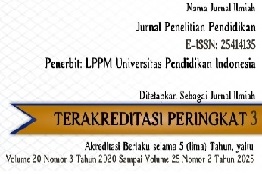Analisis Fonetik Segmentasi terhadap Inteligibilitas Pengucapan Bahasa Inggris Guru Bahasa Inggris Non-Penutur Asing
Abstract
Analisis fonetik segmentasi ini bertujuan untuk mengetahui seberapa jelas pelafalan bahasa inggris guru bahasa inggris non-pentur asli dalam mengartikulasi bunyi-bunyi fonemik terkait fonetik segmentasi. Penelitian ini merupakan penelitian deskriptif kualitatif dengan 3 partisipan yang dipilih secara sengaja berdasarkan beberapa kriteria yang telah ditetapkan. Pengumpulan data dilakukan dengan dua jenis instrumen yaitu PIT (Tes kejelasan pengucapan) dan tes sejenis IELTS. Analisis data dilakukan dengan menggunakan penjelasan fonetik berbasis kesalahan. Temuan mengungkapkan bahwa dalam hal performa segmental, semua peserta memiliki inteligibilitas pengucapan yang tidak memadai dikarenakan banyaknya ditemukan distorsi beberapa konsonan seperti frikatif (dental, labio-dental, alveolar, dan palato-alveolar), dan juga fonemik vokal seperti vokal terbuka dan vokal dekat. Analisis ataupun kajian tentang artikulasi fonemik (segmental) amat sangat dibutuhkan bagi semua orang yang berbahasa inggris baik dari kalangan masyarakat umum, pelajar, terlebih lagi pengajar dikarenakan faktor pencentus utama unintelligible pronunciation (pengucapan yang tidak dipahami) adalah jumlah kesalahan pada artikulasi (produksi) fonemik dari kelas konsonan dan vokal.
Keywords
Full Text:
PDFReferences
Aliaga-García, C. (2007). The role of phonetic training in L2 speech learning. Proceedings of the Phonetics Teaching and Learning Conference (PTLC2007), University College London. Available at http://www.phon.ucl.ac.uk/ptlc/ptlc2007_web_procindex.html.
Brinton, D.M. (2012). Pronunciation Instruction in Burns, A. and Richards, J.C. (eds.) The Cambridge Guide to Pedagogy and Practice in Second Language Teaching. Cambridge: Cambridge University Press, pp. 246-257
Celce-Murcia, M., Brinton, D.M. and Goodwin, J.M. (2010). Teaching pronunciation: A reference for teachers of English to speakers of other languages. New York: Cambridge University Press.
Chapko, M. K., Liu, C., Perkins, M., Li, Y., Fortney, J. C., & Maciejewski, M. L. (2009). Equivalence of two healthcare costing methods: bottom-up and topdown. Health Economics, 18(10), pp. 1188–1201. doi: 10.1002/hec.1422
Davis, V. (2008). Contribution of error analysis to foreign language teaching. Mersin University Journal of the Faculty of Education. 2, 261-270.
Derwing, T. M., & Munro, M. J. (2005). Second Language Accent and Pronunciation Teaching: A Research-Based Approach. TESOL Quarterly, 39(3), 379. DOI: 10.2307/3588486
Habibi, B. G. (2016). Phonetic errors in secondary students. Conaplin Journal, I(1), 56-69.
Harmer, J. (2007) The practice of English language teaching. 4th ed. Harlow: Pearson Education Limited.
Houghton, M. (2003). Pronunciation practice activities: A resource book for teaching English pronunciation. Cambridge: Cambridge University Press.
Jenkins, J. (2006). Global intelligibility and local diversity: possibility or paradox? In R.Rubdy, & M. Saraceni (Eds.), English in the world. Global rules, global roles (pp. 32-39), London: Continuum.
Kelly, G. (2007). How to teach pronunciation. China: Pearson Longman.
Komariah, S. (2016). Leaning to speak with phonetics. The 61st TEFLIN Confrence (pp. 1142-1145). Surakarta: UNS Press.
Martínez-Flor, A., Usó-Juan, E., & Alcón Soler, E. (2006). Towards acquiring communicative competence through speaking. In Usó-Juan, E., & Martínez-Flor, A. (eds). Current Trends in the Development and Teaching of the Four Language Skills. Berlin: Mouton de Gruyter, 139-157.
Merriam. (2009). How to teach pronunciation in SLA contexts. Malaysia: Longman.
Morley, J. (1991). The Pronunciation component in teaching English to speakers of other languages. TESOL Quarterly, 25(3), pp. 481-520.
Odlin , G. (1989). Rhythm and vowel quality in accents of English. Research in Language, 2, 135-147.
Porzuczek, A. (2015). Handling global and local English pronunciation errors. In Waniek-Klimczak, E. & Pawlak, M. (Eds.), Teaching and researching the pronunciation of English (pp. 169-187). New York: Springer.
Pourhosein-Gilakjani, A. (2016). A study on the situation of pronunciation instruction in ESL/EFL classrooms. Journal of Studies in Education, 1(1), 1-15.
Robinson, T. S. (2018). Approaches and methods in language teaching. Second edition. Cambridge: Cambridge University Press.
Schartz, G. (2010). Rhythm and Vowel Quality in Accents of English. Research in Language, 8. DOI 10.2478/v10015-010-0011-8.
Simon, J., & Taverniers, S. (2011). Gathering on words in English pronunciation instruction. Research in Language, 8, 169-155.
Sobkowiak, W. (2001). English phonetics for Poles. Poznań: Wydawnictwo Poznańskie,
Subtirelu, N. (2013). ‘What do learners want?: a re-examination of the issue of learner preferences regarding the use of ‘native’ speaker norms in English Language Teaching’, Language Awareness, 22(3), pp. 270-291.
Szpyra-Kozlowska, J., & Stasiak, S. (2010). From focus on words in English pronunciation instruction. Research in Language, 8, 163-177.
Tergujeff, E. (2013). Learner perspective on English pronunciation teaching in an EFL context. Research in Language, 11(1), pp. 81-95.
Timmis, I. (2002) Native speaker norms and International English. ELT Journal 56 (3), 240-249.
Utami, M. (2018). Developing a manual toward phomenics. Conaplin Journal, I(1), 56-69.
Waniek-Klimczak, E. (2001). Context for teaching English phonetics and phonology at Polish Universities and College: A survey. Teaching English phonetics and phonology II: Accent ’97 (pp. 5-17). Lodz : Wydawnictwo Uniwersytetu Lodzkiego.
Zajac, M. (2015). Compiling a corpus-based list of words commonly mispronounced. In Waniek- Klimczak, E. & Pawlak, M. (Eds.),Teaching and researching the pronunciation of English. (pp. 153-167). New York: Springe.
DOI: https://doi.org/10.17509/jpp.v20i3.27618
Refbacks
- There are currently no refbacks.
Copyright (c) 2020 Jurnal Penelitian Pendidikan


